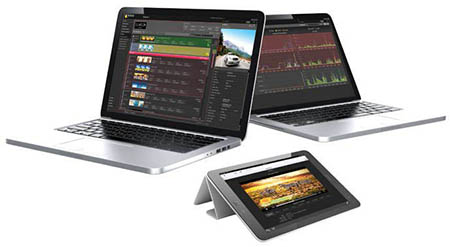Playout: Breaking Out of the Box
HAMILTON, N.J.—As the industry moves rapidly towards pure softwarebased Integrated channel playout (ICP) systems, the term channel in a box (CiAB) may now need to be replaced with “channel in a cloud.”
Since the software architecture of the latest ICP systems lends itself to IP-driven virtualized master control, private data centers and public cloud deployments—running on commodity hardware—the industry is parting ways with the self-contained, dedicated hardware on which CiAB solutions have been based.
The term was originally coined because the functionality that used to require separate, heavy iron master control devices—for channel branding, playout and automation—was integrated within a single appliance. While integration enabled streamlined, automated operation, broadcasters could no longer mix and match the different third-party devices they wanted to use.
Now, with the freedom to design solutions entirely in software, top vendors are now on-boarding best-in-class, third-party software engines—such as graphics, closed captioning, loudness control, watermarking and Dolby encoding—within their integrated channel playout systems to expand their functionality and boost customer appeal.

Florical’s Acuitas Integrated Channel Playout systemFLEXIBLE DESIGN
“As an industry, we began by integrating third-party master control hardware systems, followed by collapsing everything into one box, and now we’ve come full circle to where we’re back to integrating third-party products again, only this time in software,” said Eric Openshaw, general manager of Pebble Beach Systems, in Denver. “We’re not graphics experts or captioning experts. But we know who is, and we can plug their applications into our box.”
“With the pluggable software architecture of our Orca and Dolphin CiABs, we’ve already integrated the Pixel Power graphics engine and Dolby E encoding, among other specialized third-party components, with plans to add more,” Openshaw added. “The result is that the customer is not locked in, a better quality product goes to air, and the system can keep pace with the latest trends and requirements.”
Get the TV Tech Newsletter
The professional video industry's #1 source for news, trends and product and tech information. Sign up below.
SOA ARCHITECTURE
“This industry is rapidly moving away from dedicated hardware to a softwarecentric IP workflow. And with our Acuitas ICP system, we’re taking things a step further by moving away from the limitations a closed one-brand/one-box environment poses,” said Shawn Maynard, vice president/general manager of Florical Systems in Gainesville, Fla.
“By forming collaborative partnerships with other top industry vendors, and leveraging Acuitas’ modular, software-oriented architecture, we can now embed popular, best-in-class, third-party software right alongside the broad array of integrated functionality our system already offers,” Maynard said.
At the 2016 NAB Show, Florical announced an option to integrate Vizrt realtime graphics and effects software into Acuitas, and by the 2017 NAB Show, Acuitas will add the Ross Xpression real-time motion graphics system. With this software-centric approach, any brand of software-based capabilities—such as graphics, effects, audio loudness control, watermarking and more—could be integrated within Acuitas and placed under its automated management and control.
CIAB, ONLY BETTER

Evertz’ Mediator-X media asset management system is part of the company’s integrated channel playout solution. According to Mike O’Connell, executive vice president for Burbank, Calif.-based Pixel Power, broadcasters are gravitating to virtualized playout platforms because there is greater operational flexibility and freedom to moving “outside the box.” “They want the operational efficiency that integrated channel playout systems provide, but they don’t want to give up the best-inbreed systems they’ve become accustomed to,” he said. “If their on-air look depends on our Clarity CG, broadcasters are often reluctant to forego that channel branding that’s so closely tied to their brand equity and revenue.”
Pixel Power is working with major automation vendors, including Pebble Beach, to incorporate its Clarity real-time DVE and 3D graphics engine into their CiABs, as well as within its own StreamMaster virtualized playout platform. A pure-software CIAB, StreamMaster offers live playout from generic local servers, on-premise data centers, or from the (Amazon) cloud, making it easier to support new IP–based workflows and distribution models.
MIGRATING TO IP
While broadcasters may want to transition to IP all at once, the reality is that most will need to support some or all of their existing SDI infrastructures for some time to come, according to Andy Warman, director of production and playout strategy and market development for Harmonic in San Jose, Calif.
“That’s why our Spectrum X integrated channel playout system is designed to support a hybrid SDI/IP infrastructure while evolving and adapting to the facility’s changing environment,” he said. “Facilities can mix SDI and IP systems—like multiviewers, routers and processing gear—and simulcast a mix of SDI and IP signals within the same workflow.”
As a software-centric product, Spectrum X supports IP-based integrated channel playout, compliant with the SMPTE 2022-6 standard for switching uncompressed video over IP. The company also plans to incorporate SMPTE 2110—for uncompressed video and audio over IP—once it’s ratified. For transport steam-based workflows, Harmonic’s Spectrum XE offers similar functionality using MPEG-2 transport streams for switching and delivering compressed video over IP.
FLEXIBLE CONFIGURATIONS
By virtue of its flexible, cloud-native design, “Versio is a 100 percent software-and IP-based integrated playout channel technology that can take on any deployment configuration broadcasters may need,” said Steve Smith, CTO/Cloud for Imagine Communications.
“The direction we’re aggressively taking is focused on data centers, cloud deployments or a hybrid of the two. That’s what most of our customers want to talk about right now, not the dedicated hardware box,” Smith said. “However, if a broadcaster isn’t ready for IP-based workflows yet, Versio can also be deployed as a traditional CiAB hardware-based appliance that provides a disruption-free IP transition.”
Versio has already been deployed in virtualized master control centers run by major broadcast organizations, including Disney/ABC Television Group in New York, N.Y., as well as several media companies in the Middle East.
VIRTUALIZATION
According to Neil Maycock, executive vice president and general manager of Media Software Solutions at U.K.-based Snell Advanced Media, SAM is working with major broadcasters to deploy integrated channel playout systems in virtualized, data center environments.
ICE SDC (Software Defined Channel) enables a virtualized channel running on generic computing systems, making it wellsuited to cloud and data center settings.
“Broadcasters today are looking for greater flexibility and scalability, especially with respect to ramping up new revenue-producing services,” Maycock said. “It’s very attractive to have elastic capacity in their data center so they can quickly launch virtualized channels, especially if the programming is just intended to run for a short duration. They’re also using their virtualized ICE systems for disaster recovery and back-up.
“Virtualizing their master control allows broadcasters the power and agility to compete more effectively in this dynamic media landscape,” he added. While ICE SDC is a pure software version of SAM’s flagship ICE system, both configurations offer “five nines” of reliability and an extensive toolset for multichannel, multiregion and multiplatform operations.
SEAMLESS OPERATION
Evertz is focused on delivering solutions that are easy to use regardless of which underlying SDI, IP, hardware or software technology is employed, according to Dan Turow, vice president of file-based solutions for the Burlington, Ont.-based company.
“Advanced orchestration and system control software is absolutely key in today’s operational environment,” he said. “If you need to get a source to a destination, you don’t want to have to worry about specific multicast IP addresses. Your control layer should be designed to simplify things, abstract that complexity away and deliver intuitive ways of performing the tasks that need to get done.”
In addition to CiAB appliances, Evertz also offers an integrated channel playout solution comprised of three Evertz components: Mediator-X media asset management, PlayTime automation, and Overture-RT-Live integrated playout solution. Mediator-X also handles content prep, QC, versioning, transcoding and other advanced workflows for delivering content to non-linear platforms. And Mediator integrates with a number of third-party software solutions, such as AutoQC and transcoding tools, to deliver workflows that specific customers need.
PRICE/PERFORMANCE
When Dallas-based RUSHWORKS first developed its A-LIST BROADCAST automation system for traditional and Internet broadcasting, the target market was the 4,000+ low-power TV stations that were priced out of the high-end ICP and broadcast automation market. But today, RUSHWORKS President Rush Beesley says that A-LIST sales are very strong, with the customer base expanding to include full-power single and multi-channel DTV stations, cable stations, church networks, and government channels. “With the cost-efficiencies of point-to-point IP network delivery, we’re now seeing multistation groups using A-LIST to centralize their master control and playout operations,” he said.
A-LIST Station-In-A-Box integrates key functionality, such as matrix routing switchers, NAS servers, traffic and billing software, and playlist tools for scheduled and on-demand playout. The system handles a mix of MPEG-2, H.264, AVI, MOV and MXF clips within its playlist, and HD/SD media formats are automatically transcoded based on the resolution output setting.
RACING TO THE C3 WINDOW
Grass Valley has expanded its iTX integrated channel playout line with iTX On-Demand, which enables the linear broadcast chain to handle the new responsibilities of delivering content to platforms such as VOD and social media, globally.
“Rather than waiting for the linear broadcast to end to start creating the DAI-capable C3, C7 and D4 Catch-up TV masters, which many broadcasters do in a separate workflow, iTX On-Demand makes it easier and more efficient to use the same media assets, metadata and channel branding you’re already using for the linear broadcast to repurpose those versions,” said Scott Rose, senior director of product management for Grass Valley.
“With iTX On-Demand, the C3 master can be in the works several hours before air-time for pre-recorded content—in a nonlinear fashion that’s faster than real-time—so that content is ready to go out concurrently from the linear broadcast chain,” Rose said. “The growth in broadcasting is now tied to delivering additional content to more platforms. Our iTX products enable broadcasters to scale up to handle this higher volume without adding overhead. By not paying attention to this time-critical market demand, you can potentially lose revenue and viewers you won’t get back.”
FASTER CHANNEL SET-UP
PlayBox Technology recently debuted AirBox Neo, which offers greater channel playout and branding functionality, and the ability to integrate easily with 4K UHD environments. AirBox Neo is a family of modules that can be configured as a CiAB, based on enterprise-class servers. It enables quicker setup, smaller footprint, and faster ROI.
According to Van Duke, USA Sales Manager for PlayBox Technology, USA, in West Palm Beach, Fla., “we’re now seeing a new industry trend—growing interest in cloudbased deployments,” Duke said. PlayBox Technology also offers CloudAir, which is structured as a software-as-a service solution enabling playout, branding, back up and disaster recovery via the cloud.
With CloudAir, Duke said, “We’re reducing the time it takes to put a new live 24/7 channel on the air from months or weeks down to just a matter of hours.”

